Southern New Jersey
-
- Racing for 30GW—and a Piece of the US Offshore Wind Pie Marine News, Oct 2021 #40
“30 by 30” is the rallying cry for all concerned with the burgeoning U.S. offshore wind business. In Spring 2021, the Secretaries of Energy, Interior and Commerce resolved to deploy 30 gigawatts (GW) of electricity generated from offshore turbines by 2030. Consultants McKinsey, in a recent article frame the value proposition for this clean fuel source, writing: “During the industry’s 30-year evolution, costs have fallen so sharply that offshore wind now compares favorably with competing energy sources.” For vessel owners, renewable energy brings opportunity.
The thrust of near-term U.S. activity will be in the waters of New England and the mid-Atlantic states, with Gulf of Mexico and West Coast also on the drawing boards. Initially, installations will be fixed to the ocean floor (analogous to jack-ups in the offshore oil and gas realm). At present, two small projects are generating a meager 42 megawatts (MW): from Block Island Wind (five turbines at 6 MW each) and a demonstration project, Coastal Virginia Offshore Wind, or CVOW (two turbines at 6 MW). The Biden administration, in contrast to its predecessor, has been eager to advance a renewables agenda, and has jumpstarted approvals processes for new installations that had stalled out prior to the inauguration earlier this year.
Offshore wind development is not without its challenges. Objections from affluent seaside residents led to the demise of the Cape Wind project in Nantucket Sound. More recently, flare-ups between, developers of the 132 MW South Fork Wind (a partnership between Ørsted and Eversource), and residents in Wainscott, Long Island, regarding the proposed onshore interface for electrical cabling) have been in the news. In numerous cases, offshore wind interests have worked to overcome objections from the fishing industry. The same South Fork Wind project (moving rapidly through the approvals process, and set to come online in late 2023) provides an example. Its developers announced collaboration with Sea Services North America, and its partner fishermen in Rhode Island, Connecticut and New York, to support safe navigation around the in and around South Fork Wind and two other projects: the 704 MW Revolution Wind project (online in 2025) serving Rhode Island and Connecticut, and the 924 MW Sunrise Wind project, located east of Montauk, which will serve New York. Sea Services North America in effect, puts fisherman to work “… provid[ing] scouting vessels and monitoring services to assist …project research vessels in successfully locating, identifying and avoiding fishermen’s gear during pre-construction marine surveys. This partnership helped improve communication and coexistence during the surveys.”
Ørsted and Eversource had suggested that more collaboration might be in the cards, at developments Ocean Wind (with Ørsted partnering with PSEG in a 1.1 GW offshore southern New Jersey) and Skipjack Wind Farms (with its first phase, 120 MW, serving the Delmarva Peninsula, coming online in 2026). Cooperation with the fishing fleets is also key to deliberations in Maine in advance of the Federal leasing process, where politicians have inched toward a deal keeping offshore wind further out from the shore.
Developers of these and other offshore installations are pushing ahead with a plethora of projects on the path to gaining requisite approvals and set to come online in the mid-2020s. The initial phase of Vineyard Wind (800 MW, a partnership of Copenhagen Infrastructure Partners (CIP) and Avangrid Renewables), which fell victim to regulatory inertia during 2020, gained environmental approvals from Bureau of Energy Management (BOEM) and other agencies. The Sunrise Wind project east of Montauk will be the subject of public sessions beginning in September, which will guide a subsequent Federal environmental review, in advance of further approvals from Interior and Commerce. Other projects moving through BOEM’s process include Ocean Wind (1.1 MW, offshore New Jersey) and the Coastal Virginia Offshore Wind (CVOW) project, which could see as many as 200 turbines, producing 2,600 MW, or more, of electricity.
With project approvals comes vessel construction. Installation vessels attract headlines, with their hefty price-tags and limited supply (in the face of demand for installation for 1,500 + turbines in U.S. waters and many more internationally in the coming decade). Dominion Energy, the owner of the Coastal Virginia project, inked a deal with a lessor consortium (after laying out upfront payments prior to the December 2020 keel laying) to complete construction for a Jones Act compliant wind turbine installation vessel (WTIV) at Brownsville, Texas shipbuilder Keppel AmFELS. The price of the WTIV, named Charybdis, which will work for Dominion out of Norfolk on CVOW, after an anticipated 2023 delivery, is around $600 million including debt of roughly $550 million.
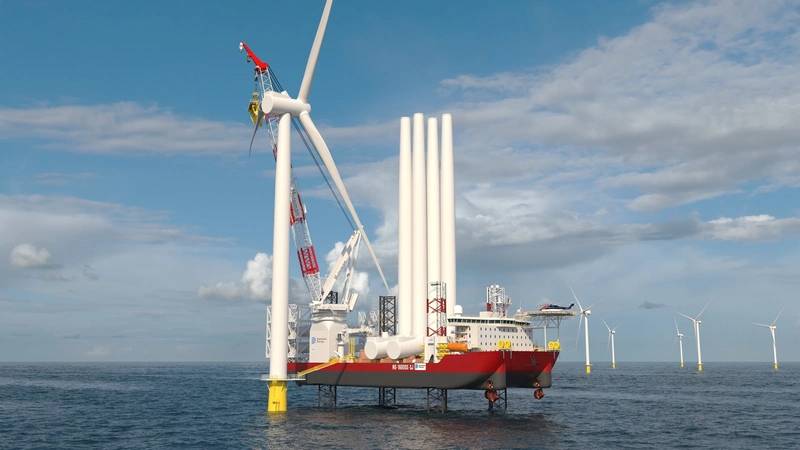 Keppel AmFELS is currently building the first ever Jones Act WTIV. (Image: Dominion Energy)
Keppel AmFELS is currently building the first ever Jones Act WTIV. (Image: Dominion Energy)The existing U.S. projects saw workarounds with turbines erected by European-owned WTIVs (with Jones Act compliant feeder barges), and will continue to do so. The installation phase of the already approved Vineyard Wind project will see the Belgian company DEME Offshore as contractor. According to a release from Vineyard Wind, “Foss [a U.S. company] will provide the Jones Act compliant feeder vessels, a concept by which the wind turbines will be transported from the port of New Bedford to the specialized DEME Offshore US LLC installation jack-up vessel.” In late August, DEME Offshore announced that it would be upgrading the crane capacity on its jack-up Sea Installer (presently working on the Hornsea project offshore U.K.) to 1,600 tons, in advance of work installing Vineyard Wind’s General Electric Haliade-X turbines (13 MW).
Jones Act WTIVs will be an important part of the installation mix up and down the coastline. Indeed, Charybdis will be put out on charter to Ørsted/Eversource, working out of New London, Conn., before going to work for Dominion off the Virginia Coast. Logistical considerations (and sourcing of U.S. manufactured components) will likely drive demand for additional WTIVs built and owned in the U.S.
The New York-listed WTIV specialist Eneti (recently in the news with its early August acquisition of Great Yarmouth, U.K. based Seajacks) has said that it is in discussions with U.S. yards regarding construction of a Jones Act WTIV. The company’s chairman, Emanuele Lauro, said, in a May 2021 investor call, “We are intent on providing a state-of-the-art solution to our customers so that they can comply with the Jones Act as they bring renewable energy to the U.S. consumer.” Eneti is building a $330 million GustoMSC-designed WTIV at Daewoo Shipbuilding & Marine Engineering Co (DSME) in S. Korea, for 2024 delivery; with a Huisman crane, installations of 20 MW turbines at water depths of up to 65 meters. will be possible, according to the company.
After installation, the need for servicing offshore turbines and electrical infrastructure will also create new business for U.S. yards and vessel operators. Ørsted/ Eversource, with multiple projects in the Northeast, have taken the lead when it comes to service vessels- contracting with oil patch stalwart Edison Chouest Offshore for construction of a service operations vessel (SOV), with a price-tag estimated to be around $80 million, at its multiple yards in the Gulf Coast.
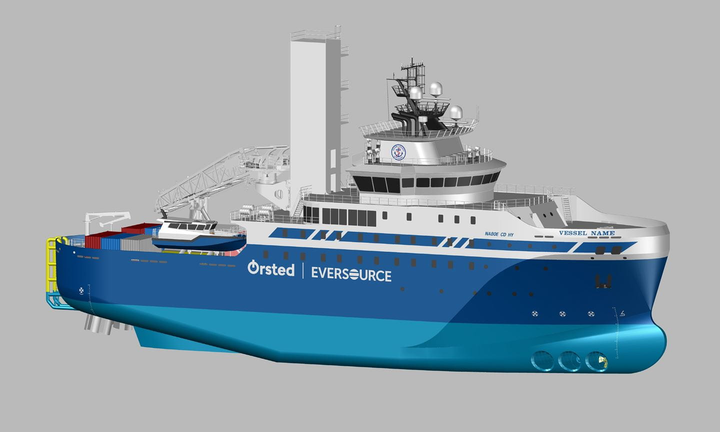 Edison Chouest Offshore is building a Jones Act SOV (Image: Edison Chouest Offshore)
Edison Chouest Offshore is building a Jones Act SOV (Image: Edison Chouest Offshore)Joint ventures between U.S. companies and European companies with wind expertise are an emerging template. Østensjø Rederi, the Norwegian operator with experience in the North Sea, has inked a joint venture agreement with U.S. service provider Foss Maritime (which is active in towing and ship assist, in addition to its barge ownership). Crowley, a Jones Act powerhouse which recently created a new subsidiary specifically to serve the offshore wind segment, has agreed to cooperate with ESVAGT, a Danish operator of more than 40 SOVs. Another company with offshore ambitions is Green Shipping Line (GSL), founded by Percy Pyne IV, a New York-based entrepreneur with shipping in his blood. GSL, aiming to build a vessel designed by DEKC Maritime (Netherlands) with 2023 delivery, at Moran Iron Works in Michigan. Keystone Shipping Company, a veteran of the U.S. energy trades, would be slated to operate the vessel, according to announcements from GSL (which had also reportedly been in discussions with Norwegian/ German wind farm planners).
Facilities for vessels provides another set of challenges, effectively requiring the creation of an infrastructure—largely from scratch—to supply and service a burgeoning industry. “Local content” is often a stipulation in power purchase agreements typically funded at the state level. Yet such facilities don’t lend themselves to economies of scale. Observers suggest that supply chains will evolve around a combination of “regional” ports (Norfolk, Va., South Jersey, and Narragansett Bay ports are examples), in conjunction with localized facilities. Besides New Bedford (where Vineyard Wind will be staged), examples would include Setauket, near Port Jefferson, which would serve as a base for Sunrise Wind’s operations/ maintenance activities, or, in Connecticut- New London (slated to serve the Revolution Wind, and Sunrise Wind projects, both of which will be served by Charybdis, and the South Fork Wind project ). Also, in the Nutmeg State, Bridgeport will be a hub for the Park City Wind development, with same owners as Vineyard Wind, to produce electricity from turbines located south of Martha’s Vineyard. In Virginia, Dominion Energy has entered into a 10-year lease on 72 acres at the Portsmouth Marine Terminal, where turbines will be assembled before transfer to the WTIV. Part of the site was used as a staging facility by Ørsted, in the demonstration phase of the CVOW project.
Extensive survey activity has created employment opportunities for both U.S. and non U.S. survey vessels that might otherwise have been working in the oil and gas realm. Equinor (with partner BP) developing Empire Wind in the New York Bight, has hired a vessel from Geoquip, while the Dutch vessel Deep Helder (chartered from owner Seamar to contractor MMT Group), working out of New London, has been hired for Ørsted and Eversource’s multiple projects east of Long Island. A trio of U.K registered vessels, Ocean Researcher, Ocean Endeavour and Ocean Observer, have been working off the New Jersey coast for Ørsted on its Ocean Wind and Skipjack Wind projects. Tidewater’s DP-2 PSV Regulus has also been working in the same vicinity, on the Atlantic Shores project (a joint venture of Shell and EDF Renewables).
Deeper and bigger are watchwords of the business on its path to “30 by 30”. Eneti, the WTIV behemoth, explained in an August, 2021 presentation, “Offshore wind turbines are continuously increasing in size and capacity. While the largest deployed model is currently 9.5 MW, models up to 14-15 MW are set to be commercialized over the next few years,” adding that “Offshore wind installations are also moving further from shore and into deeper water where better quality wind resources are available.” They also noted, “Most projects commissioned through 2018 have been within 50 kilometers of shore, however, several large projects in the pipeline are 100 kilometers or more from shore.”
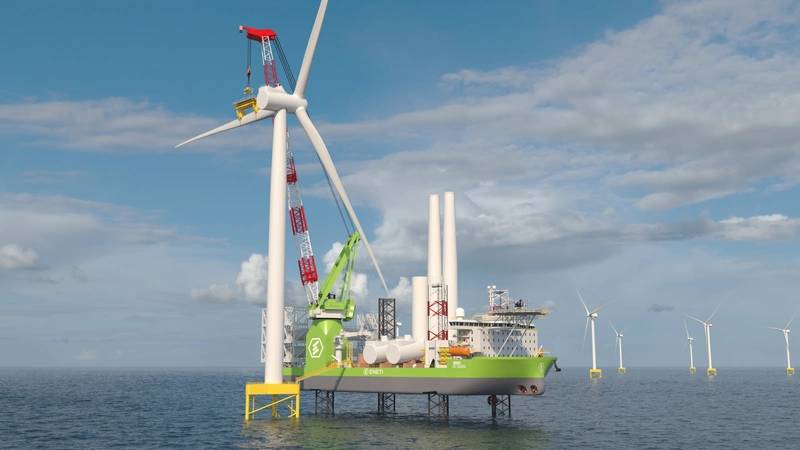 Eneti jack-up WTIV illustration (Image: GustoMSC)
Eneti jack-up WTIV illustration (Image: GustoMSC)Looking ahead, BOEM is in early stages of soliciting comments on a project offshore northern California. Because water depths in the potential lease site, 15 nautical miles out in the Pacific, range from 300 feet to 700 feet, floating turbines (assembled shoreside and then towed out to sea) would be deployed. Offshore Maine would also likely see floating turbines. Offshore wind is expected to evolve much like offshore oil and gas, where shallow water jack-ups gave way to deepwater “floaters”. In its late 2020 report on floating wind, class society DNV said, “Because floating wind can be deployed in any depth of water, it opens up these sites—bringing wind power in reach of much more of the world’s population including the mega cities of Asia Pacific.”
Though the ongoing push to renewable energy will see a big pivot from combustion to electrification, power generation does not stop with electricity. The Atlantic Shores project (which could eventually supply more than 2 GW of electricity), off the coast of Atlantic City, will include a pilot project to produce “green hydrogen” using offshore wind!
CTVs
In 2016, Rhode Island-based Atlantic Wind Transfers (AWT) put into service the U.S.’ first-ever vessel purpose-built for offshore wind services. The 21-meter crew transfer vessel (CTV) Atlantic Pioneer was constructed by Blount Boats to serve America’s first commercial offshore wind project, the five-turbine, 30 MW Block Island Wind Farm, which became operational in the final month of 2016. Last year saw the launch of two new Jones Act CTVs: WindServe Marine’s WindServe Odyssey and AWT’s Atlantic Endeavor, built at Senesco and Blount respectively. CTVs are typically aluminum catamarans, used for transporting wind farm technicians and other personnel, and sometimes equipment, out to sites on a daily basis.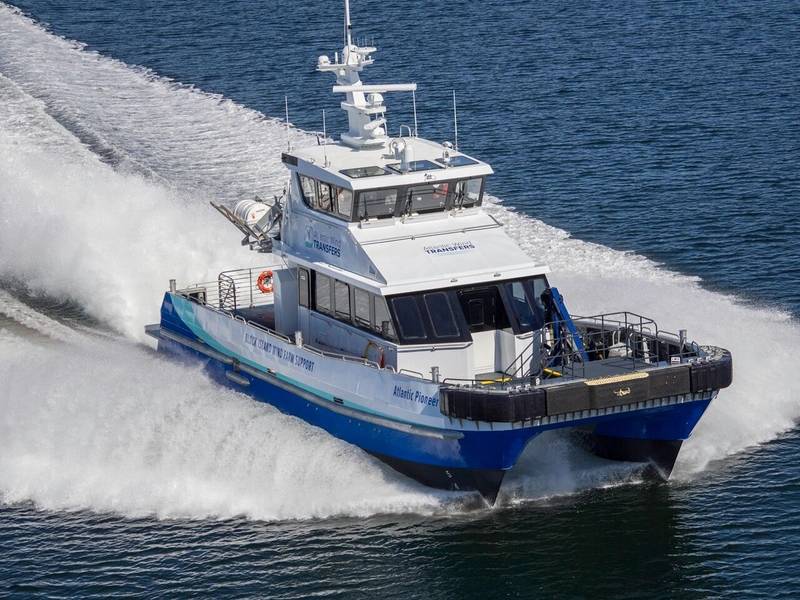 (Photo: Atlantic Wind Transfers)
(Photo: Atlantic Wind Transfers)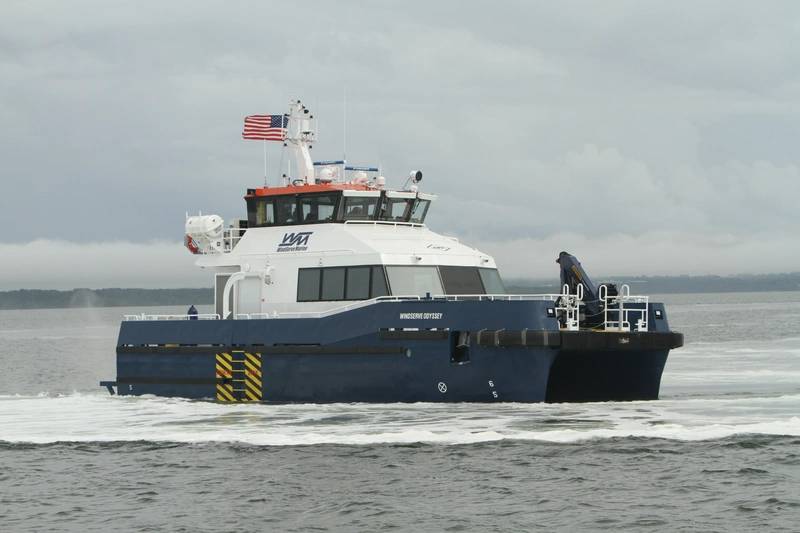 (Photo: WindServe Marine)
(Photo: WindServe Marine) -
- 2023 Shipbuilding Report: US Passenger Vessels Marine News, Feb 2023 #30
under construction following the 2022 delivery of Arthur Imperatore, named for the company’s founder), from Yank Marine, which has yards in southern New Jersey. The aluminum catamaran style ferries are powered by twin Cummins 2300 hp engines and ZF transmissions. Nearby operator Seastreak, linking midtown
-
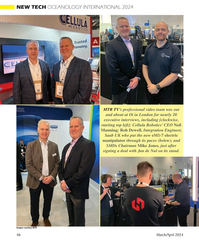 )
March 2024 - Marine Technology Reporter page: 46
)
March 2024 - Marine Technology Reporter page: 46NEW TECH OCEANOLOGY INTERNATIONAL 2024 MTR TV’s professional video team was out and about at Oi in London for nearly 20 executive interviews, including [clockwise, starting top left]: Cellula Robotics’ CEO Neil Manning; Rob Dewell, Integration Engineer, Saab UK who put the new eM1-7 electric manipulator
-
 )
March 2024 - Marine Technology Reporter page: 45
)
March 2024 - Marine Technology Reporter page: 45ronments. The new agreement will address speci? c techni- cal gaps in the UUV defense and offshore energy markets especially for long duration, multi-payload mission opera- tions where communications are often denied or restricted. As part of the new alliance, Metron’s Resilient Mission Autonomy portfolio
-
 )
March 2024 - Marine Technology Reporter page: 44
)
March 2024 - Marine Technology Reporter page: 44NEW TECH OCEANOLOGY INTERNATIONAL 2024 Image courtesy Metron/Cellula Teledyne Marine acquires Valeport: Matt Quartley, MD, Valeport and Ole Søe-Pedersen, VP & Image courtesy Teledyne Marine GM Teledyne Marine announce the deal in London. Pictured (L-R): Cellula Robotics, President, Eric Jackson, Metron
-
 )
March 2024 - Marine Technology Reporter page: 43
)
March 2024 - Marine Technology Reporter page: 43Image courtesy Kongsberg Discovery Image courtesy Teledyne Marine New Products Teledyne Marine had its traditional mega-booth at Oi, busy start to ? nish. Image courtesy Greg Trauthwein offers quality sub-bottom pro? ling capability without the need tion of offshore windfarms. GeoPulse 2 introduces new
-
 )
March 2024 - Marine Technology Reporter page: 42
)
March 2024 - Marine Technology Reporter page: 42NEW TECH OCEANOLOGY INTERNATIONAL 2024 Image courtesy Greg Trauthwein Image courtesy BIRNS MacArtney launches the new ultra-compact ø12.7 mm SubConn Nano connector. Innovative connectivity built on 45 years of ? eld-proven and market-trusted design. Image courtesy MacArtney Birns celebrated its 70th
-
 )
March 2024 - Marine Technology Reporter page: 41
)
March 2024 - Marine Technology Reporter page: 41Image courtesy Outland Technology Image courtesy Exail Image courtesy Submaris and EvoLogics Vehicles The ROV-1500 from Outland Technology represents a leap forward in underwater robotics, a compact remotely operated vehicle (ROV) weighing in at less than 40 lbs (19kg) the ROV- 1500 is easy to transport
-
 )
March 2024 - Marine Technology Reporter page: 40
)
March 2024 - Marine Technology Reporter page: 40NEW TECH OCEANOLOGY INTERNATIONAL 2024 All photos courtesy MTR unless otherwise noted NEW TECH, PARTNERSHIPS LAUNCH IN LONDON With Oceanology International now one month in the rear-view mirror, MTR takes a look at some of the interesting technologies launched before, during and after the London event.
-
 )
March 2024 - Marine Technology Reporter page: 39
)
March 2024 - Marine Technology Reporter page: 39Photo courtesy Global Ocean Design Figure 7 A 35Ah AGM lead-acid battery is tested using the West Mountain Radio CBA to show the effect of simply ? lling the battery voids with mineral oil as a compensating ? uid. The CBA is programmed to cut-off at a voltage of 10.50v. The top line (red) shows the
-
 )
March 2024 - Marine Technology Reporter page: 27
)
March 2024 - Marine Technology Reporter page: 27SEA-KIT USV Maxlimer returning from HT-HH caldera in Tonga. © SEA-KIT International data and further assess ecosystem recov- ery. What is known, noted Caplan-Auer- bach, is that the impact of submarine vol- canoes on humans is rare. “The HT-HH eruption was a tragedy, but it was very unusual. It let us
-
 )
March 2024 - Marine Technology Reporter page: 25
)
March 2024 - Marine Technology Reporter page: 25Auerbach explained that ideally, “one ? ed layers of geothermal activity,” noted changes over an area of 8,000 km2. They would have both instruments: seismom- Skett, “and the change in salinity and dis- found up to seven km3 of displaced ma- eters to detect and locate subsurface ac- solved particles for
-
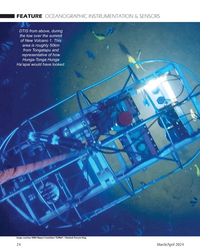 )
March 2024 - Marine Technology Reporter page: 24
)
March 2024 - Marine Technology Reporter page: 24FEATURE OCEANOGRAPHIC INSTRUMENTATION & SENSORS DTIS from above, during the tow over the summit of New Volcano 1. This area is roughly 50km from Tongatapu and representative of how Hunga-Tonga Hunga Ha’apai would have looked. Image courtesy NIWA-Nippon Foundation TESMaP / Rebekah Parsons-King 24
-
 )
March 2024 - Marine Technology Reporter page: 23
)
March 2024 - Marine Technology Reporter page: 23elatively inactive since 2014, the Hunga Tonga–Hunga Ha‘apai (HT-HH) submarine volcano began erupting on December 20, 2021, reaching peak intensity on January 15, 2022. This triggered tsunamis throughout the Pa- R ci? c, destroyed lives and infrastructure, and generated the largest explosion recorded
-
 )
March 2024 - Marine Technology Reporter page: 22
)
March 2024 - Marine Technology Reporter page: 22FEATURE OCEANOGRAPHIC INSTRUMENTATION & SENSORS Aerial view of HT-HH volcano, showing new multibeam depth data overlaid on islands satellite image. © SEA-KIT, NIWA-Nippon Foundation TESMaP 22 March/April 2024 MTR #3 (18-33).indd 22 4/4/2024 9:08:10 AM
-
 )
March 2024 - Marine Technology Reporter page: 19
)
March 2024 - Marine Technology Reporter page: 19About the Author vey with the pipe tracker is not required, resulting in signi? - Svenn Magen Wigen is a Cathodic Protection and corrosion control cant cost savings, mainly related to vessel charter. expert having worked across The major advantage of using FiGS on any type of subsea engineering, design
-
 )
March 2024 - Marine Technology Reporter page: 18
)
March 2024 - Marine Technology Reporter page: 18TECH FEATURE IMR There are also weaknesses in terms of accuracy because of FiGS Operations and Bene? ts signal noise and the ability to detect small ? eld gradients. In Conventional approaches to evaluating cathodic protection this process there is a risk that possible issues like coating (CP)
-
 )
March 2024 - Marine Technology Reporter page: 15
)
March 2024 - Marine Technology Reporter page: 15sensor options for longer mission periods. About the Author For glider users working in ? sheries and conservation, Shea Quinn is the Product Line Manager the Sentinel can run several high-energy passive and active of the Slocum Glider at Teledyne Webb acoustic sensors, on-board processing, and imaging
-
 )
March 2024 - Marine Technology Reporter page: 14
)
March 2024 - Marine Technology Reporter page: 14TECH FEATURE TELEDYNE SLOCUM GLIDERS to hold over 3.5 times as many lithium primary batteries as the the water column and its thrusters give it the ability to stay standard Slocum Glider, and to physically accommodate up to on track in strong currents or other dif? cult ocean condi- 8 different sensor
-
 )
March 2024 - Marine Technology Reporter page: 13
)
March 2024 - Marine Technology Reporter page: 13nyone familiar with glider hardware options integrated for a broad Glider answers that need,” said Shea autonomous underwater ve- range of missions. Quinn, Slocum Glider Product Line hicles (AUVs) is certainly “As the use of Slocum Gliders grew, Manager at TWR. A familiar with the popular- so did
-
 )
March 2024 - Marine Technology Reporter page: 4
)
March 2024 - Marine Technology Reporter page: 4Editorial NIWA-Nippon Foundation TESMaP/ Rebekah Parsons-King www.marinetechnologynews.com ast month marked the resounding NEW YORK 118 E. 25th St., New York, NY 10010 return of Oceanology Interna- Tel: (212) 477-6700; Fax: (212) 254-6271 tional in London, perennially one Lof the world’s most important
-
 )
March 2024 - Marine Technology Reporter page: 2
)
March 2024 - Marine Technology Reporter page: 2March/April 2024 On the Cover Volume 67 • Number 3 Image courtesy NIWA-Nippon Foundation TESMaP / Rebekah Parsons-King 8 Subsea Defense Black Sea Mines When the shooting stops in the Ukraine, the tough work of clearing mines will commence. By David Strachan 12 Gliders Slocum Sentinel 22 Teledyne
-
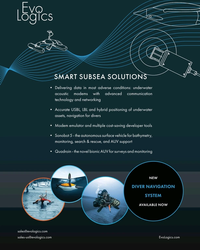 )
March 2024 - Marine Technology Reporter page: 2nd Cover
)
March 2024 - Marine Technology Reporter page: 2nd CoverSMART SUBSEA SOLUTIONS • Delivering data in most adverse conditions: underwater acoustic modems with advanced communication technology and networking • Accurate USBL, LBL and hybrid positioning of underwater assets, navigation for divers • Modem emulator and multiple cost-saving developer tools • Sonobot
-
 )
April 2024 - Maritime Reporter and Engineering News page: 43
)
April 2024 - Maritime Reporter and Engineering News page: 43“The industry is an ecosystem which includes owners, managers, mariners, shipyards, equipment makers, designers, research institutes and class societies: all of them are crucial,” – Eero Lehtovaara, Head of Regulatory & Public Affairs, ABB Marine & Ports All images courtesy ABB Marine and Ports provi
-
 )
April 2024 - Maritime Reporter and Engineering News page: 41
)
April 2024 - Maritime Reporter and Engineering News page: 41Nautel provides innovative, industry-leading solutions speci? cally designed for use in harsh maritime environments: • GMDSS/NAVTEX/NAVDAT coastal surveillance and transmission systems • Offshore NDB non-directional radio beacon systems for oil platform, support vessel & wind farm applications
-
 )
April 2024 - Maritime Reporter and Engineering News page: 39
)
April 2024 - Maritime Reporter and Engineering News page: 39Tech Files Latest Products, Systems and Ship Designs “Wall Climbing Robot” Danish Pilot calls gets ClassNK Nod LEGO Model "A tribute build to a work life at sea" Image courtesy MOL, Sumitomo Heavy Industries lassNK granted its Innovation Endorse- Image courtesy Espen Andersen/DanPilot ment for
